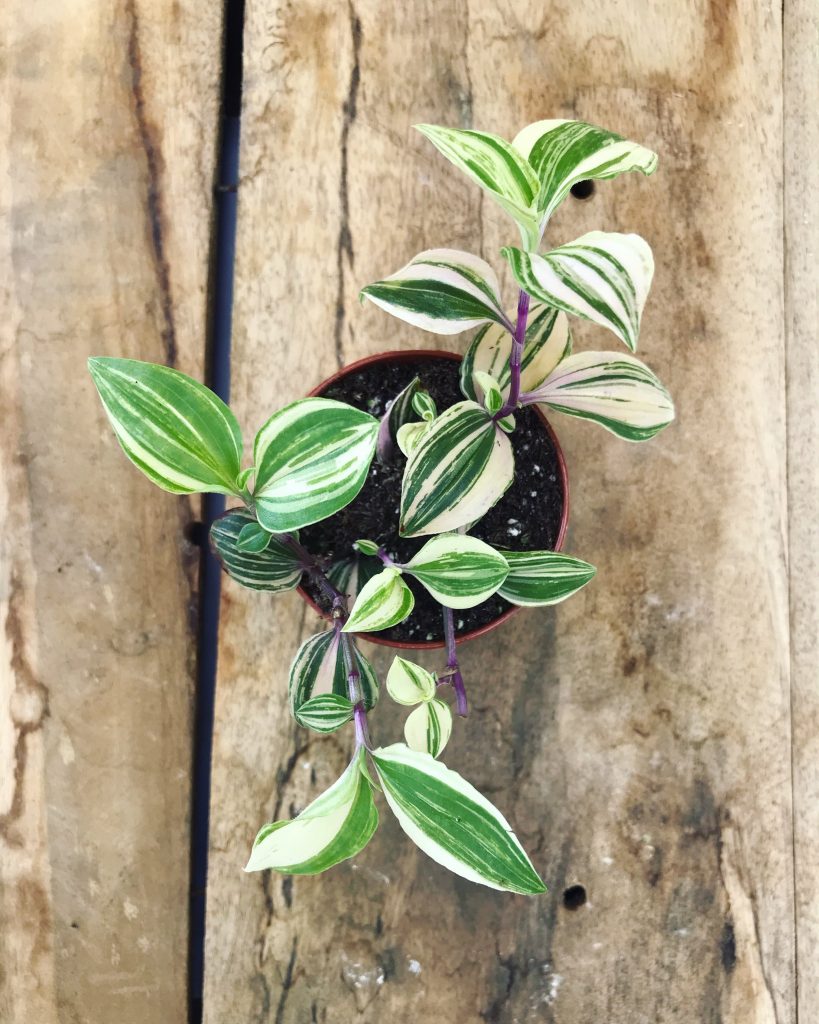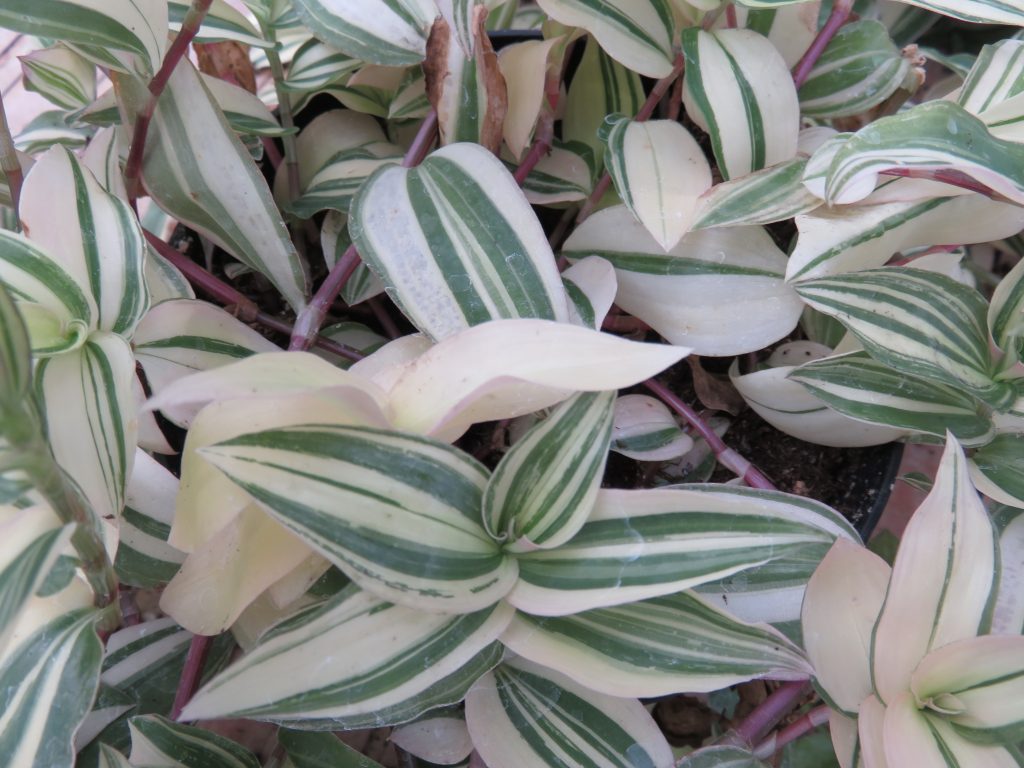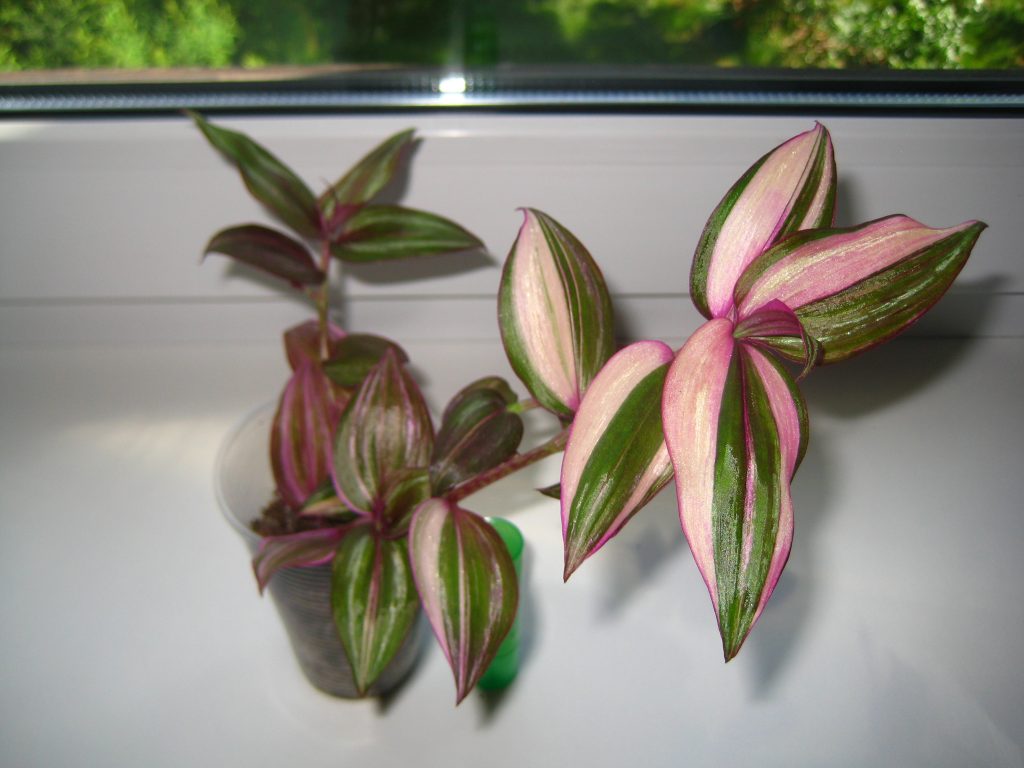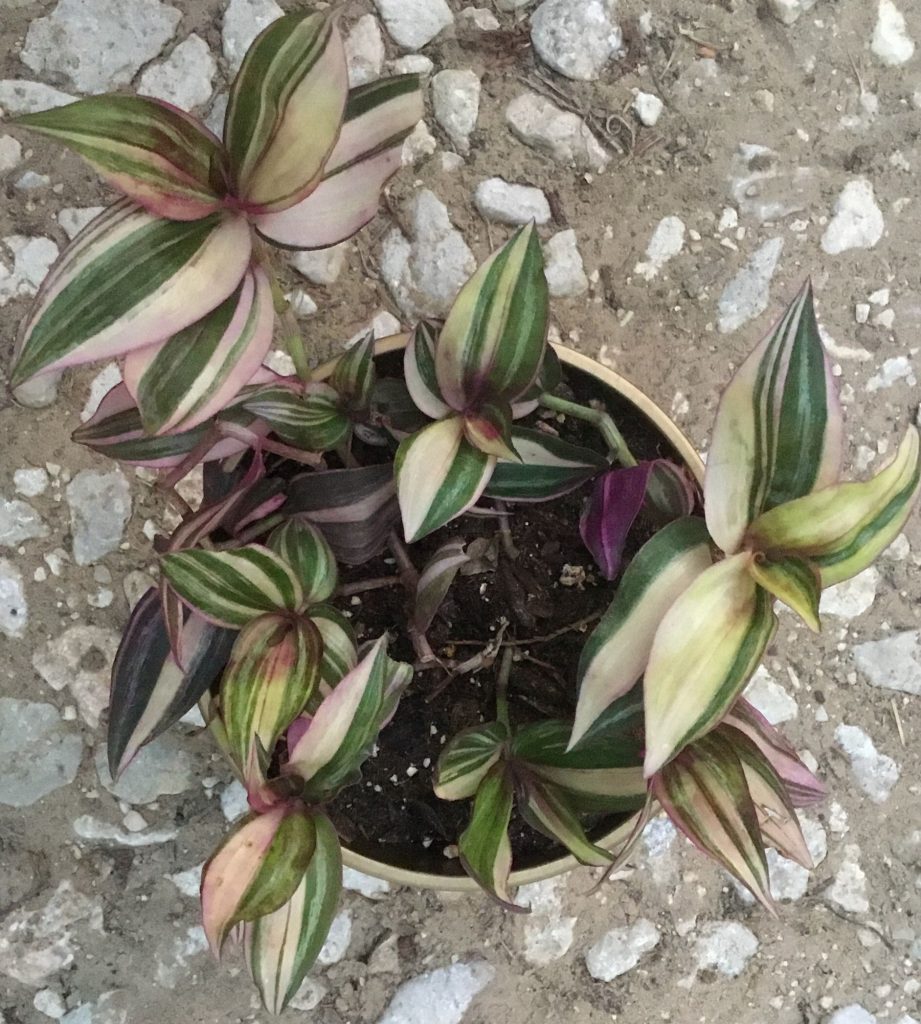Tradescantia Multicolored - step by step care
Multicolored Tradescantia is a perennial herb from the genus of the same name. The florists retained the former name of Reo covered, derived from the name of a mythological character - a nymph. Homeland from the subtropical regions of Mexico and America. It is widely cultivated in private gardening.

Tradescantia multicolored is wild
Botanical characteristic
Tradescantia Reo is a herbaceous plant formerly part of the Kommelinov family. In its natural environment, a wild crop is found in tropical forest belts, on the shores of natural reservoirs, and sometimes grows on rocky slopes.
The decorativeness of the flower is provided by bright foliage, which can be monochromatic green or purple, with a striped pattern of different shades, including white, pink and yellow.
Description:
- the stem is erect, the structure is fleshy, the height is up to 0.4 m, with numerous branches growing in an arbitrary order, often under the weight of large foliage and, in combination with lateral illumination, acquire a hanging shape;
- leaves 0.2 m or more long, about 6-8 cm wide, lanceolate, horizontally directed, sitting position, elastic structure, glossy surface, the color of the upper part of the leaf plate is often dark green, the inner one is red-purple, the foliage is present striped ornament, on the surface there is an orange and red hairy pubescence, the lower tier falls off as the plant grows, turning the Tradescantia into a palm tree that looks like a dracaena in appearance;
- the root system is fibrous, with thin roots-villi;
- inflorescences are small, white, attached on short pedicels, closed in a boat-cover, consisting of two or three leaves of a violet-colored bracts.
With a properly organized microclimate, flowering is observed in any season throughout the entire calendar year, but in most cases it occurs in mid-summer.
Varieties
Several varieties of Tradescantia are grown at home.
- Rhoeo vittata, or striped. Differs in light green longitudinal stripes on leaf plates.
- Rhoeo stripe in pink, or pink. The color of a striped pattern on foliage with a pink tint.
- Rhoeo discolor cv. Vittata and Rhoeo discolor cv. Compacta, or multicolored. They have a high decorative effect due to the contrasting color.
Purchase and adaptation
The best time to buy a home flower is spring. Before the onset of the cold season, he will have time to adapt to new conditions.

Tradescantia multicolored wild
When purchasing, you should pay attention to the appearance of the plant. Healthy Tradescantia:
- bright saturated color corresponding to the variety;
- there are no spots and signs of pests on the leaves;
- root system without damage.
Price - from 500 rubles.
Immediately after purchase, the flower culture is quarantined, isolating it from other home flowers. For 2 weeks, the plant undergoes adaptation, and at this time it is not transplanted or fed.
Growing conditions
A sunny place is suitable for planting. The flower culture is developing intensively on the east and west sides of the premises. When located in the north, it needs additional lighting, when located in the south, it needs shading during the hours of solar activity.
Covering variety does not tolerate permutation, therefore, a permanent place of growth for it is chosen immediately.
For the full development of an indoor flower, a ready-made substrate, slightly acidic or neutral in acidity, is suitable for growing ornamental deciduous plants.
You can make the soil yourself by mixing fertile garden soil, peat mixture and river sand in proportions of 5: 3: 2. To increase the aeration of the soil mixture, agroperlite or agrovermiculite is added.
A flower culture needs good drainage. Requires high humidity, at a level of 70-75% and x responds well to spraying on foliage.
Temperature
Optimal mode:
- in summer - about 25 ° С;
- in winter - not lower than 10 ° С.
When grown on balconies and in open conditions, Tradescantia can withstand a short-term drop in temperature to 5 ° C, but such a drop causes the leaves to lose turgor. Poorly tolerates drafts.
Lighting
The flower is susceptible to prolonged exposure to the sun. Needs diffused light and shading from aggressive rays in order to prevent burns of the vegetative mass.
With a lack of lighting, it begins to stretch and changes the color of the leaves to pale. The optimal daylight hours are 8 or more hours. In winter, the lack of light is compensated by the use of artificial sources - fluorescent lamps.
Care
Planting and transplanting
For planting Tradescantia, in which the development of roots occurs in diametrically opposite directions, a wide and not very deep pot is more suitable. Before filling the container with a substrate, drainage from construction expanded clay or broken brick is laid on the bottom.

5 multicolored tradescantia
- A young plant is transplanted annually with a 1/3 soil replacement;
- An adult needs a transplant every 3-4 years.
The most suitable way is transshipment. The best time is from spring to early summer.
Watering
Tradescantia is unpretentious for watering, copes with a short drought, but is susceptible to prolonged dryness of the soil.
Optimal watering regime:
- in spring and summer, at the stage of active vegetation, the flower culture is watered at intervals of up to 2-3 times a week, as the surface layer of the substrate dries up by 3-5 cm;
- in winter, in combination with a lower temperature, watering is reduced to 1-3 times a month.
Top dressing
Homemade Tradescantia is fed in spring and summer, from March to August. Ready-made fertilizers designed for decorative indoor flowers are suitable for feeding. The frequency of application is once every 2 weeks.
Pruning
Does not require formation. Sluggish leaves and dried inflorescences are subject to pruning. Regular pinching of the shoots will help to ensure the splendor and development of the flower culture in width.
Reproduction methods
At home, multi-colored Tradescantia can be propagated by seeds or cuttings. An adult shrub with a well-formed root system can be transplanted by dividing.

Tradescantia multicolored is a wild plant
Seminal
The method is used infrequently, because it is difficult to obtain high-quality planting material. Seeds must be soaked before sowing, which increases the percentage of their germination. Growth stimulants, for example, Epin, are added to the water.
Seeds are sown into the ground without deepening, sprinkling on top with a layer of earth up to 2 mm thick.The plantings are covered with glass or plastic wrap to create a greenhouse effect and placed in a place where the temperature is maintained at about 20-22 ° C.
The flower culture is capable of self-propagation by seeds, throwing them out as they ripen from the bracts, but this requires ideal conditions.
The first shoots from seeds appear 3-6 weeks after sowing. When sprouts germinate, the greenhouse is regularly ventilated, the dried soil is moistened with a spray bottle.
When 2-3 leaves grow on seedlings, the shelter is removed, the plantings dive into separate containers and provide care as for an adult flower.
Cuttings
Breeding Tradescantia with shoots gives guaranteed high results and preserves the quality characteristics of the parent plant. For propagation by cuttings, lateral shoots that grow from the roots are taken. They are cut off from the mother bush, the lower part is cleaned of foliage and placed in water to form a root mass.
Spring is more suitable for cuttings. Rooting of autumn blanks takes much longer.
Tradescantia can also be propagated by cuttings cut from the main stems up to 15 cm long. They are rooted in water with activated carbon (1 tablet per 200 ml) or in a peat-sand mixture. The optimum temperature that should be adhered to for active rooting is at least 20 ° C.
After the roots grow up to 1.5-2 cm long, the cuttings are planted in individual containers and provide care as for an adult plant.
Dividing the bush
For division, adult flowers aged 3 years and older, which have a well-formed root system, are suitable.
The parent bush is often divided in half, but if there are more processes, there can be more than two divisions. The basic rule is that roots and shoots are preserved on each part.
The separated plants are planted in pots with a slight depth, up to 2 cm.
Treatment of diseases and pests
Tradescantia belongs to flower crops that rarely get infections and are quite resistant to pests. Abundant watering and stagnant moisture sometimes leads to rotting of the root system, and an excess of direct sunlight causes burns.

Tradescantia multicolored wild plant
The loss of decorativeness by a home flower is more often associated with a violation of care.
| Type of defeat | Control measures |
| Powdery mildew or gray mold. Its appearance provokes too abundant watering. | The affected vegetative parts are cut off, the plant is transplanted into a fresh substrate with preliminary disinfection of the pot, removing rotten roots. |
| The foliage turns yellow and becomes shallow, becomes pale, the stems are stretched. Occurs due to lack of lighting. | The flower culture is rearranged in a place well-lit by diffused sunlight. The required length of daylight hours is provided with the help of additional lighting with fluorescent lamps. |
| The foliage becomes brown and shriveled. The main reason lies in the unsuitable temperature and composition of water. | Water for irrigation is used standing, non-chlorinated, at room temperature. |
| Shield. | Insects are removed by hand by wiping the foliage with soapy water (50 g per 1 liter of water). The plant is treated with an insecticidal agent, for example, Aktara. |
| The tips of the leaves dry out and turn brown. Occurs when you are surrounded by dry air. | The flower is sprayed over the foliage. Air humidifiers are installed in the room or the humidity is increased in any other available way. |
Healing properties
The plant is widely used in folk medicine due to its healthy chemical composition:

Tradescantia multicolored wild plant or not
- with rheumatism, heated foliage is applied in the form of compresses, because it helps relieve pain syndrome;
- in case of damage to the skin, crushed tradescantia is used as a therapeutic mask;
- for the treatment of intestinal disorders and the normalization of digestion, an infusion is made from Reo inflorescences by boiling for 0.5 hours and further straining.
Some peoples have found other uses for it.
- Mexicans use milky juice instead of blush, which is irritating to the skin and causes allergic dermatitis with redness.
- For the inhabitants of Cuba, a useful liquid serves as a means of stopping the bleeding of the gums, and with a decoction of the leaves, they treat the upper respiratory tract.
Signs and beliefs
In esotericism, several signs are associated with Tradescantia. She is credited with magical properties, believing that a flower culture is able to cleanse rooms of negative energy and neutralize aggressive thoughts.
There is a superstition among the people that it is impossible to keep such a plant at home, because it promotes separation.
According to Feng Shui, a flower is a converter of negative energy into positive.

